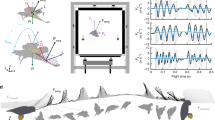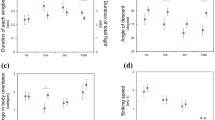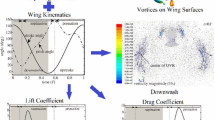Abstract
An unconventional mechanism of ventral clap is exploited by hovering passerines to produce lift. Quantitative visualization of the wake flow, analysis of kinematics and evaluation of the transient lift force was conducted to dissect the biomechanical role of the ventral clap in the asymmetrical hovering flight of passerines. The ventral clap can first abate and then augment lift production during the downstroke; the net effect of the ventral clap on lift production is, however, positive because the extent of lift augmentation is greater than the extent of lift abatement. Moreover, the ventral clap is inferred to compensate for the zero lift production of the upstroke because the clapping wings induce a substantial elevation of the lift force at the end of the downstroke. Overall, our observations shed light on the aerodynamic function of the ventral clap and offer biomechanical insight into how a bird hovers without kinematically mimicking hovering hummingbirds.












Similar content being viewed by others
References
Alexander DE (2002) Nature’s flyers. The Johns Hopkins University Press, Baltimore
Cooter J, Baker PS (1977) Weis-Fogh clap and fling mechanism in Locusta. Nature 269:53–54
Dabiri JO (2005) On the estimation of swimming and flying forces from wake measurements. J Exp Biol 208:3519–3532
Dabiri JO, Colin SP, Costello JH (2006) Fast-swimming hydromedusae exploit velar kinematics to form an optimal vortex wake. J Exp Biol 209:2025–2033
Dickinson MH, Lehmann FO, Sane SP (1999) Wing rotation and the aerodynamic basis of insect flight. Science 284:1954–1960
Ellington CP (1984) The aerodynamics of hovering insect flight. IV. Aerodynamic mechanisms. Philos Trans R Soc Lond B 305:79–113
Guermond JL (1990) A generalized lifting-line theory for curved and swept wings. J Fluid Mech 211:497–513
Hedenström A, Spedding GR (2008) Beyond robins: aerodynamic analysis of animal flight. J R Soc Interface 5:595–601
Hedenström A, Rosén M, Spedding GR (2006) Vortex wakes generated by robins Erithacus rubecula during free flight in a wind tunnel. J R Soc Interface 3:263–276
Hedrick TL, Cheng B, Deng X (2009) Wingbeat time and the scaling of passive rotational damping in flapping flight. Science 324:252–255
Johansson LC, Wolf M, Hedenström A (2010) A quantitative comparison of bird and bat wakes. J R Soc Interface 7:61–66
Lehmann LO (2004) The mechanism of lift enhancement in insect flight. Naturwissenschaften 91:101–122
Muijres FT, Johansson LC, Barfield R, Wolf M, Spedding GR, Hedenström A (2008) Leading-edge vortex improves lift in slow-flying bats. Science 319:1250–1253
Norberg UML (1990) Vertebrate flight. Springer, Berlin
Norberg UML (2002) Structure, form, and function of flight in engineering and the living world. J Morph 252:52–81
Peng J, Dabiri JO (2008) An overview of a Lagrangian method for analysis of animal wake dynamics. J Exp Biol 211:280–287
Peng J, Dabiri JO, Madden PG, Lauder GV (2007) Non-invasive measurement of instantaneous forces during aquatic locomotion: a case study of the bluegill sunfish pectoral fin. J Exp Biol 210:685–698
Pesavento U, Wang ZJ (2009) Flapping wing flight can save aerodynamic power compared to steady flight. Phys Rev Lett 103:118102. doi:10.1103
Raffel M, Willert CE, Wereley ST, Kompenhans J (2007) Particle image velocimetry: a practical guide, 2nd edn. Springer, New York
Rosén M, Spedding GR, Hedenström A (2007) Wake structure and wingbeat kinematics of a house-martin Delichon urbica. J R Soc Interface 4:659–668
Saffman PG (1992) Vortex dynamics. Cambridge University Press, New York
Spedding GR, Hedenström A (2009) PIV-based investigations of animal flight. Exp Fluids 46:749–763
Spedding GR, Rayner JMV, Pennycuick CJ (1984) Momentum and energy in the wake of a pigeon (Columba livia) in slow flight. J Exp Biol 111:81–102
Srygley RB, Thomas ALR (2002) Unconventional lift-generating mechanisms in free-flying butterflies. Nature 420:660–664
Stamhuis EJ, Nauwelaerts S (2005) Propulsive force calculations in swimming frogs. II. Application of a vortex ring model to DPIV data. J Exp Biol 208:1445–1451
Su JY, Ting SC, Chang YH, Yang JT (2011) Aerodynamic trick for visual stabilization during downstroke in a hovering bird. Phys Rev E (in press)
Taylor PM (1972) Hovering behavior by house finches. Condor 74:219–221
Ting SC, Yang JT (2008) Pitching stabilization via caudal fin-wave propagation in a forward-sinking Parrot Cichlid (Cichlasoma citrinellum × Cichlasoma synspilum). J Exp Biol 211:3147–3159
Ting SC, Yang JT (2009) Extracting energetically dominant flow features in a complicated fish wake using singular-value decomposition. Phys Fluids 21:041901. doi:10.1063/1.3122802
Tytell ED, Ellington CP (2003) How to perform measurements in a hovering animal’s wake: physical modeling of the vortex wake of the hawkmoth, Manduca sexta. Phil Trans R Soc Lond B 358:559–1566
Wang ZJ (2000) Two dimensional mechanism for insect hovering. Phys Rev Lett 85:2216–2219
Warrick DR, Bundle MW, Dial KP (2002) Bird maneuvering flights: blurred bodies, clear heads. Integ Comp Biol 42:141–148
Warrick DR, Tobalske BW, Powers DP (2005) Aerodynamics of the hovering hummingbird. Nature 435:1094–1097
Warrick DR, Tobalske BW, Powers DP (2009) Lift production in the hovering hummingbird. Proc R Soc B 276:3747–3752
Weis-Fogh T (1973) Quick estimates of flight fitness in hovering animals, including novel mechanisms for lift production. J Exp Biol 59:169–230
Young J, Walker SM, Bomphrey RJ, Taylor GK, Thomas ALR (2009) Details of insect wing design and deformation enhance aerodynamic function and flight efficiency. Science 325:1549–1552
Acknowledgments
National Science Council of the Republic of China partially supported this work under contracts NSC96-2628-E-002-256-MY3, NSC96-2628-E-002-258-MY3, NSC97-2221-E-035-087-MY3 and NSC99-2218-E007-002.
Author information
Authors and Affiliations
Corresponding author
Rights and permissions
About this article
Cite this article
Chang, YH., Ting, SC., Liu, CC. et al. An unconventional mechanism of lift production during the downstroke in a hovering bird (Zosterops japonicus). Exp Fluids 51, 1231–1243 (2011). https://doi.org/10.1007/s00348-011-1145-8
Received:
Revised:
Accepted:
Published:
Issue Date:
DOI: https://doi.org/10.1007/s00348-011-1145-8




